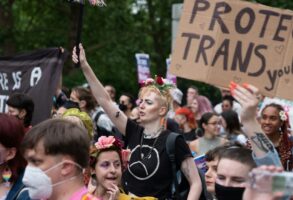Published September 9, 2014
It has been one month since Michael Brown was shot and killed in Ferguson, Mo., and we have yet to hear the police officer’s version of events. Was Officer Darren Wilson badly injured in his scuffle with Brown? Did Brown attempt to seize the officer’s weapon? Did Wilson have reason to fear for his own life?
None of these questions has yet been answered, which is odd and, frankly, suspicious. There are many possible explanations for the tragic death of Brown, ranging from justifiable self-defense by Wilson, to bad judgment by both parties, and all the way to racially motivated murder. But the news that Eric Holder’s Justice Department is undertaking an investigation hardly instills confidence that the truth will ever be known.
Though Holder didn’t go quite as far as Missouri governor Jay Nixon (D.) did in prejudging the matter — Nixon said the officer should be “prosecuted” — Holder did declare that he was investigating the shooting not just as attorney general but “as a black man.” It’s clear that the Justice investigation, like most of the reporting about Ferguson, will be premised on the racist-white-cop-shoots-black-man narrative.
The Department of Justice recently concluded an investigation into the Newark, N.J., police department, which it found to have repeatedly violated the civil rights of Newark’s black residents. The evidence? Justice found that while blacks account for 54 percent of Newark’s population, they represent 85 percent of pedestrian stops and 79 percent of arrests.
Police misconduct must always be taken seriously and vigilantly corrected, but these numbers do not come close to proving police wrongdoing, far less denial of Newarkers’ civil rights. To know whether 85 percent of pedestrian stops is a reasonable number or not, you need to know how many pedestrians of various races are committing crimes. If 90 percent of pedestrian criminals are black, then 85 percent might be too low. In any case, the relevant measure is the percentage of criminals, not, as the Justice Department explained, whether “officers . . . disproportionately stopped black people relative to their representation in Newark’s population.”
Though it wasn’t mentioned in the DOJ report, Newark’s police department is quite racially mixed. As of 2000, it was 37 percent black, 27 percent Hispanic, and 36 percent white. That’s a higher percentage of black police officers than in the typical American city of that size. According to DOJ’s own Bureau of Justice Statistics, the average percentage of black police officers in cities of between 250,000 and 500,000 is 16.5 (with 11.2 percent Hispanic).
Announcing the DOJ’s report, Holder went heavy on the implied racism. “We’re taking decisive action to address potential discrimination and end unconstitutional conduct by those who are sworn to serve their fellow citizens,” he declaimed. It’s possible that Newark police are engaged in wrongdoing, but the DOJ’s use of statistics certainly didn’t prove it. If the attorney general believes that black and Hispanic officers are stopping and arresting black people out of racial animus, he failed to say so, and if not, he’s in effect arguing that all of the misconduct is attributable to the roughly one-third of the force that is white.
The Justice Department has announced multiple investigations into the Ferguson police department and other police departments in the St. Louis area. This is consistent with Justice’s extremely aggressive pattern vis-à-vis local police. DOJ is already investigating 34 other jurisdictions for “violations of civil rights.” The department “helps” local police to avoid racial profiling, the Washington Postexplained.
Again, the image of black civilians versus white police officers dominates the imagination of the press and the Obama Justice Department. But most large and medium-sized cities have significant numbers of minority police. The police force in Washington, D.C., is majority black, as is the force in Detroit. In Los Angeles, 43.6 percent of officers are Hispanic, 11.6 percent are black, and 34.9 percent are white. In New York, 54 percent are white, 16 percent black, 24 percent Hispanic, and 4 percent Asian. The New Orleans police department is 51 percent black, 46 percent white, 2 percent Hispanic, and 1 percent Asian.
A neutral investigation into the events in Ferguson is obviously needed. Eric Holder’s Justice Department, locked as it is in a space/time warp where all American cops are presumed Bull Connors, is not likely to produce it.
— Mona Charen is a senior fellow at the Ethics and Public Policy Center. © 2014 Creators Syndicate, Inc.




